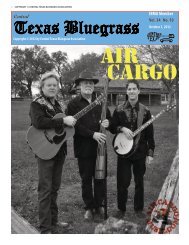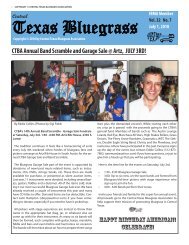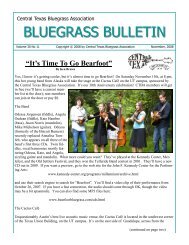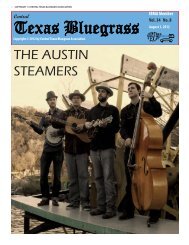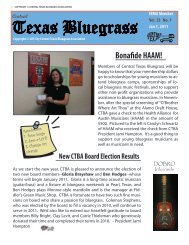Volume 33, No. 5 - Central Texas Bluegrass Association
Volume 33, No. 5 - Central Texas Bluegrass Association
Volume 33, No. 5 - Central Texas Bluegrass Association
You also want an ePaper? Increase the reach of your titles
YUMPU automatically turns print PDFs into web optimized ePapers that Google loves.
16 COPYRIGHT © CENTRAL TEXAS BLUEGRASS ASSOCIATION<br />
other a lot in the beginning.<br />
I know you do mass quantities of items but I’ve heard that you can sometimes be convinced to do special work for<br />
individuals.<br />
That’s extremely rare, maybe one half of one percent. I may do one or two jobs a year and usually when I’m<br />
absolutely forced to. I had to do a custom fingerboard name a few months ago for Conan O’Brien for Collings<br />
but normally we wouldn’t do that kind of one off work.<br />
Your web site mentions all the different types of inlays that can be purchased in large quantities so I take it that it’s<br />
not cost effective to work with the small shop that produces a few instruments per year.<br />
That’s true, that doesn’t really work for us but the stock designs are available to purchase one at a time We<br />
have most of the common pattern that everybody uses. We make and sell the ebony fingerboards that we<br />
inlay, also.<br />
What materials are used with the inlays?’<br />
Like tortoise shell?<br />
Mother of Pearl and Abalone. We use Philippine Mother of Pearl, sometimes<br />
called gold lip. It is the prettiest of all the pearl species because of<br />
the irridescent colors it shows. We also use red & green abalone.<br />
Didn’t you mention to me once long ago that there are certain pearl types<br />
that can’t be put into instruments?<br />
Yes, the federal regulations have become more and more stringent.<br />
There are only 2 shell species that are endangered, but they were never<br />
used for inlay material anyway so that’s not an issue. It’s largely focused<br />
on importing and exporting. There are laws that apply within the US,<br />
but all of the shell we use is legal shell imported through US, Mexico, &<br />
Phillipines Fish & Wildlife. Basically what the law is there for is to prevent<br />
shell from being harvested illegally. What I told you was the law is such<br />
that if the shell was illegally imported then the guitar or instrument it is<br />
in is an illegal instrument. As of 2008 all these laws apply to wood, too.<br />
<strong>No</strong>t exactly. Shell inlay is not a restricted material. It’s not endangered or threatened, but ALL wildlife materials<br />
have to be legally imported. Tortoise shell and Brazilian Rosewood cannot be imported at all.<br />
Do you make the bridges and nuts here in the shop?<br />
For nuts, we buy the bone blanks and then machine it to a slightly oversized nut. We also make our own<br />
bridges.<br />
What type of bone is it? An old friend?<br />
(Laughter) My guess is that it’s cowbones. Unbleached. Most bone that you see has been bleached and is<br />
white. I like the unbleached ones better and also they are a little greasier.



